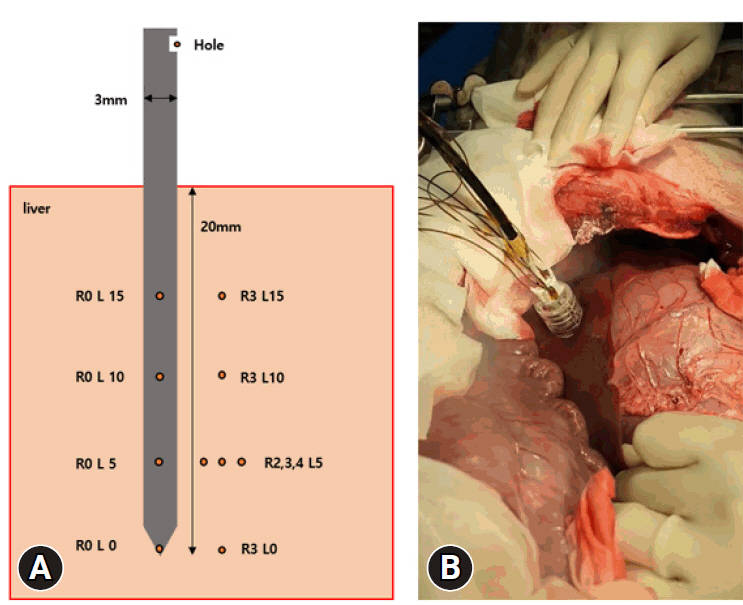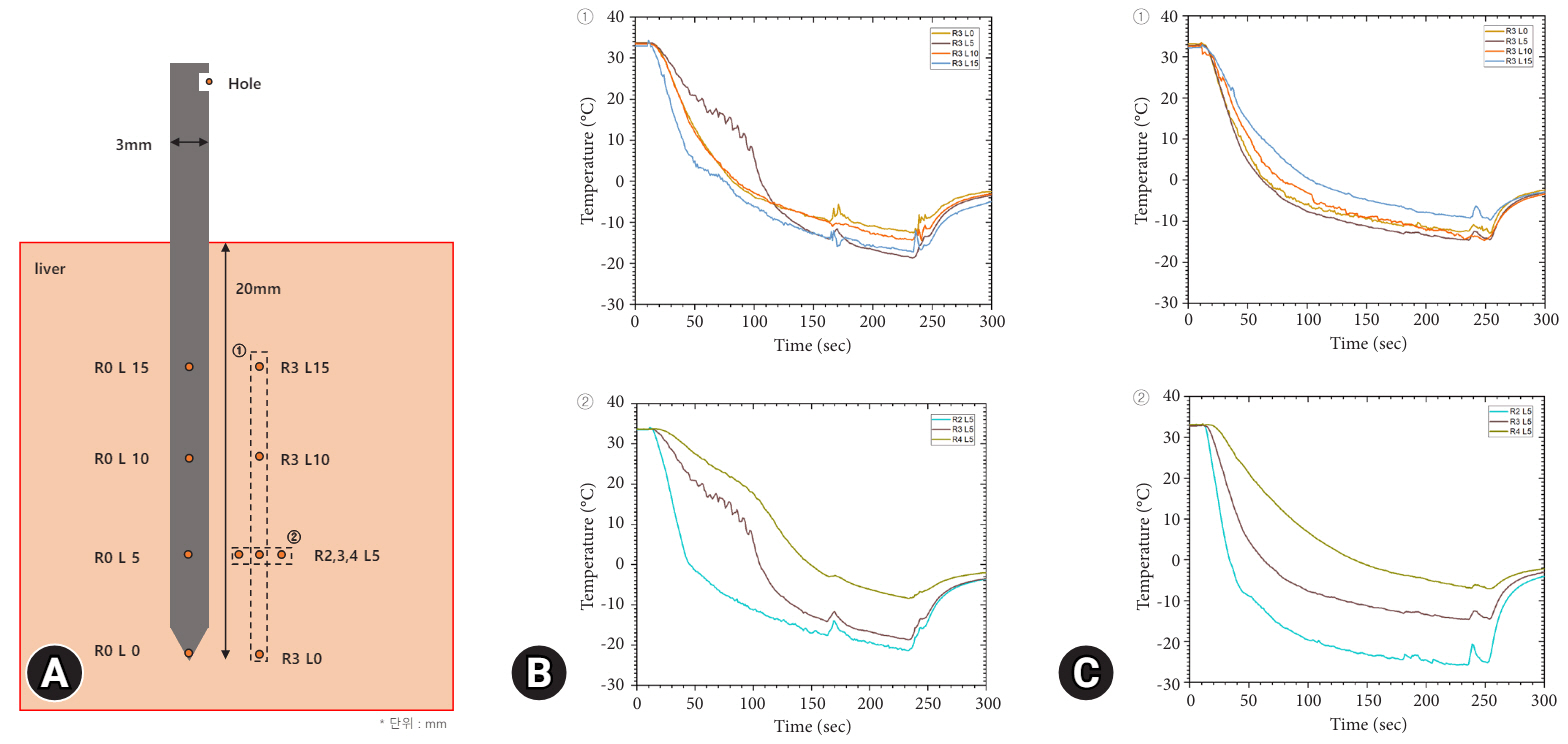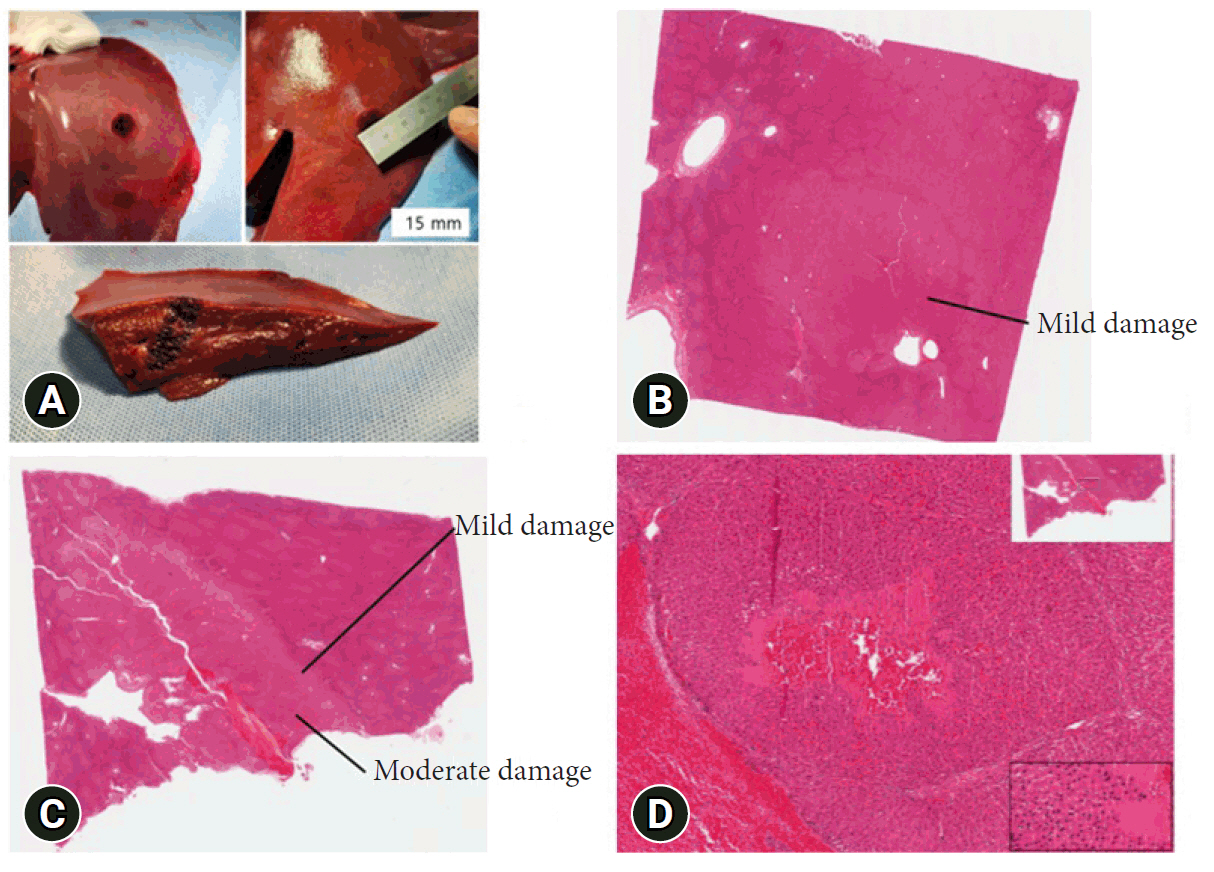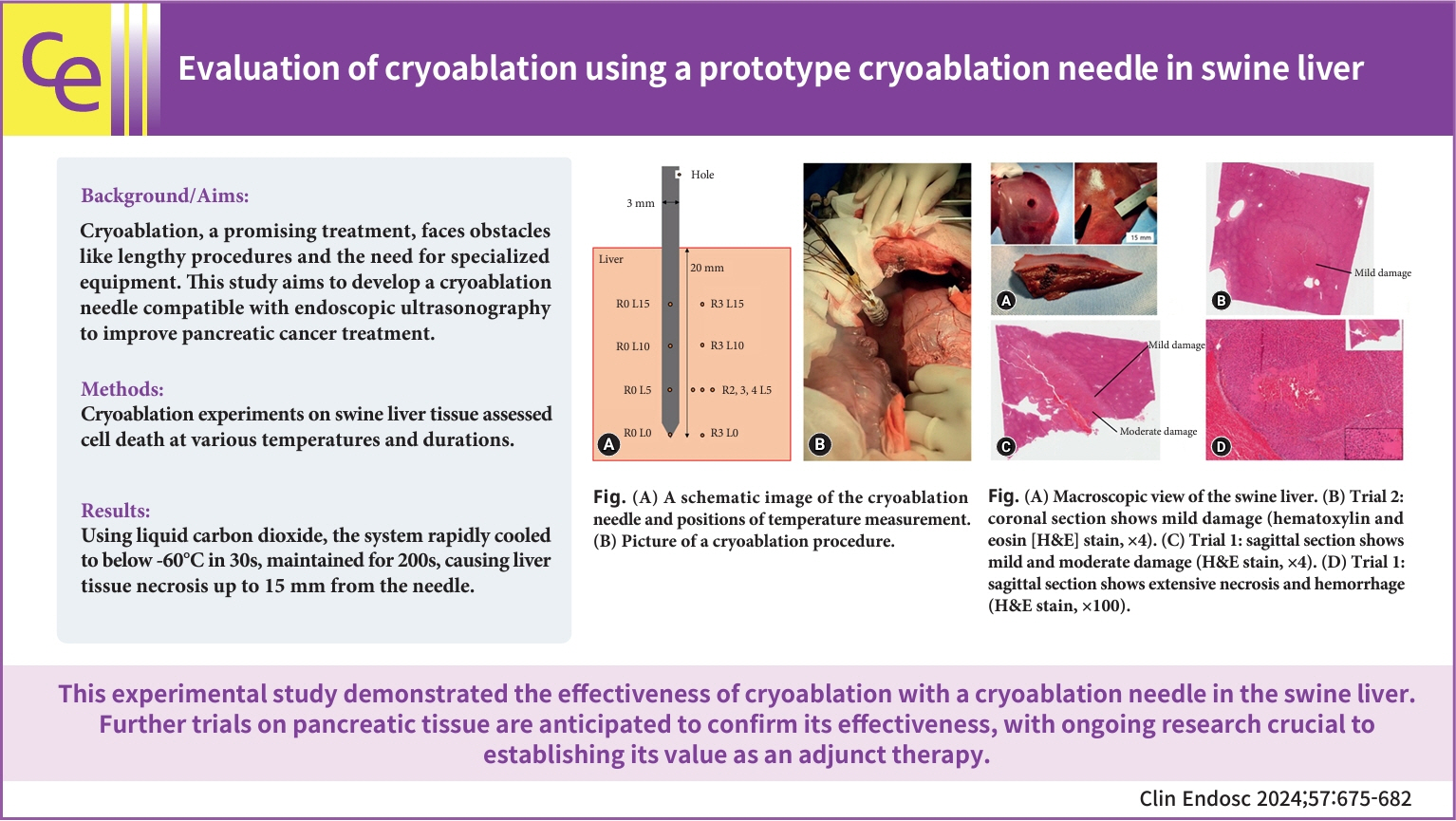Clin Endosc.
2024 Sep;57(5):675-682. 10.5946/ce.2024.024.
Evaluation of cryoablation using a prototype cryoablation needle in swine liver
- Affiliations
-
- 1Department of Mechanical Engineering, Ulsan National Institute of Science and Technology, Ulsan, Korea
- 2Division of Gastroenterology, Department of Internal Medicine and Biomedical Research Institute, Pusan National University Hospital, Busan, Korea
- 3Department of Internal Medicine, Pusan National University School of Medicine, Busan, Korea
- 4Department of Internal Medicine, CHA Gumi Medical Center, CHA University, Gumi, Korea
- KMID: 2559219
- DOI: http://doi.org/10.5946/ce.2024.024
Abstract
- Background/Aims
Pancreatic cancer poses significant challenges due to its tendency for late-stage diagnosis and high mortality rates. Cryoablation, a technique used to treat various types of cancer, has shown potential in enhancing the prognosis of pancreatic cancer when combined with other therapies. However, its implementation is often limited by the need for lengthy procedures and specialized equipment. This study aims to develop a cryoablation needle optimized for endoscopic ultrasonography to simplify its application in treating pancreatic cancer.
Methods
The study involved conducting cryoablation experiments on swine liver tissue. It utilized cryo-needles to evaluate the extent of cell death across various temperatures and durations of cryoablation.
Results
The cryoablation system, which employed liquid carbon dioxide, achieved rapid cooling, reaching temperatures below –60 °C within 30 seconds and maintained the cryoablation process for 200 seconds. These conditions resulted in necrosis of the liver tissue. Notable cellular changes were observed up to 15 mm away from the cryoablation needle.
Conclusions
This experimental study successfully demonstrated the efficacy of using a cryo-needle for cryoablation in swine liver tissue. Further trials involving pancreatic tissue are expected to verify its effectiveness, underscoring the importance of continued research to establish its role as a complementary therapy in pancreatic cancer treatment.
Figure
Reference
-
1. Siegel RL, Miller KD, Wagle NS, et al. Cancer statistics, 2023. CA Cancer J Clin. 2023; 73:17–48.2. De Grandis MC, Ascenti V, Lanza C, et al. Locoregional therapies and remodeling of tumor microenvironment in pancreatic cancer. Int J Mol Sci. 2023; 24:12681.3. Carrafiello G, Ierardi AM, Fontana F, et al. Microwave ablation of pancreatic head cancer: safety and efficacy. J Vasc Interv Radiol. 2013; 24:1513–1520.4. Gajewska-Naryniecka A, Szwedowicz U, Łapińska Z, et al. Irreversible electroporation in pancreatic cancer: an evolving experimental and clinical method. Int J Mol Sci. 2023; 24:4381.5. Xu KC, Niu LZ, Hu YZ, et al. A pilot study on combination of cryosurgery and (125)iodine seed implantation for treatment of locally advanced pancreatic cancer. World J Gastroenterol. 2008; 14:1603–1611.6. Niu L, Chen J, He L, et al. Combination treatment with comprehensive cryoablation and immunotherapy in metastatic pancreatic cancer. Pancreas. 2013; 42:1143–1149.7. He L, Niu L, Korpan NN, et al. Clinical practice guidelines for cryosurgery of pancreatic cancer: a consensus statement from the China Cooperative Group of Cryosurgery on Pancreatic Cancer, International Society of Cryosurgery, and Asian Society of Cryosurgery. Pancreas. 2017; 46:967–972.8. Luo XM, Niu LZ, Chen JB, et al. Advances in cryoablation for pancreatic cancer. World J Gastroenterol. 2016; 22:790–800.9. Kovach SJ, Hendrickson RJ, Cappadona CR, et al. Cryoablation of unresectable pancreatic cancer. Surgery. 2002; 131:463–464.10. Krishna M. Patterns of necrosis in liver disease. Clin Liver Dis (Hoboken). 2017; 10:53–56.11. Batts KP, Ludwig J. Chronic hepatitis: an update on terminology and reporting. Am J Surg Pathol. 1995; 19:1409–1417.12. Chowdhury AB, Mehta KJ. Liver biopsy for assessment of chronic liver diseases: a synopsis. Clin Exp Med. 2023; 23:273–285.13. Shinde RS, Bhandare M, Chaudhari V, et al. Cutting-edge strategies for borderline resectable pancreatic cancer. Ann Gastroenterol Surg. 2019; 3:368–372.14. Quiñonero F, Mesas C, Doello Ket al. The challenge of drug resistance in pancreatic ductal adenocarcinoma: a current overview. Cancer Biol Med. 2019; 16:688–699.15. Thomas D, Radhakrishnan P. Tumor-stromal crosstalk in pancreatic cancer and tissue fibrosis. Mol Cancer. 2019; 18:14.16. Katsuta E, Qi Q, Peng X, et al. Pancreatic adenocarcinomas with mature blood vessels have better overall survival. Sci Rep. 2019; 9:1310.17. Peng H, Shen J, Long X, et al. Local release of TGF-β inhibitor modulates tumor-associated neutrophils and enhances pancreatic cancer response to combined irreversible electroporation and immunotherapy. Adv Sci (Weinh). 2022; 9:e2105240.18. Yousaf MN, Ehsan H, Muneeb A, et al. Role of radiofrequency ablation in the management of unresectable pancreatic cancer. Front Med (Lausanne). 2021; 7:624997.19. Erinjeri JP, Clark TW. Cryoablation: mechanism of action and devices. J Vasc Interv Radiol. 2010; 21(8 Suppl):S187–S191.20. Testoni SG, Petrone MC, Reni M, et al. EUS-guided ablation with the HybridTherm Probe as second-line treatment in patients with locally advanced pancreatic ductal adenocarcinoma: a case-control study. Endosc Ultrasound. 2022; 11:383–392.21. Testoni SG, Petrone MC, Reni M, et al. Efficacy of endoscopic ultrasound-guided ablation with the HybridTherm probe in locally advanced or borderline resectable pancreatic cancer: a phase II randomized controlled trial. Cancers (Basel). 2021; 13:4512.22. Baust JM, Robilotto A, Raijman I, et al. The assessment of a novel endoscopic ultrasound-compatible cryocatheter to ablate pancreatic cancer. Biomedicines. 2024; 12:507.23. Baust JM, Santucci KL, Van Buskirk RG, et al. An in vitro investigation into cryoablation and adjunctive cryoablation/chemotherapy combination therapy for the treatment of pancreatic cancer using the PANC-1 cell line. Biomedicines. 2022; 10:450.24. Baumann KW, Baust JM, Snyder KK, et al. Characterization of pancreatic cancer cell thermal response to heat ablation or cryoablation. Technol Cancer Res Treat. 2017; 16:393–405.25. Som A, Rosenboom JG, Wehrenberg-Klee E, et al. Percutaneous intratumoral immunoadjuvant gel increases the abscopal effect of cryoablation for checkpoint inhibitor resistant cancer. Adv Healthc Mater. 2024; 13:e2301848.
- Full Text Links
- Actions
-
Cited
- CITED
-
- Close
- Share
- Similar articles
-
- Transient urine leakage following cryoablation: case report
- Percutaneous cryoablation for hepatocellular carcinoma
- Percutaneous Cryoablation of Multiple Pulmonary Endometriosis
- The Initial Experience with 3rd Generation Nephron-sparing Cryoablation for Renal Tumor
- Anti-tumor Immune Response after Cryoablation in Renal Cell Carcinoma Murine Model






